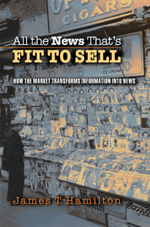 [Here’s Martin’s review of Chapter 4 of this month’s Nieman Journalism Lab Book Club selection. For more info, check here. —Ed.]
[Here’s Martin’s review of Chapter 4 of this month’s Nieman Journalism Lab Book Club selection. For more info, check here. —Ed.]
In Chapter 4 of All the News That’s Fit to Sell, James Hamilton tackles information programs on network television ranging from 60 Minutes, Dateline, 20/20 and the nightly news shows all the way down to non-fiction entertainment shows like World’s Most Amazing Videos, World’s Sexiest Commercials, and When Good Pets Go Bad (some of which appear to have been sweeps-period one-offs, not series).
In an analytical tour the force (made possible, one assumes, by a generous alotment of research assistants), he gathered transcripts of a week’s worth of these shows, carved the text up into 1,010 500-word segments, ran all of these through a software program called DICTION, which was designed to analyze the language of politics — all in order to derive for each program linguistic profile measurements in DICTION’s 33 categories, which fall into five overarching silos: certainty, optimism, activity, realism and commonality. This analysis demonstrated that there were statistically significant differences between the various programs, not surprisingly. For example, the evening news shows scored highest in activity terms, and in subcategories like numerical terms and collective terms that refer to groups and organizations. Morning news shows and news magazines scored much higher on human interest terms and self-references.
Hamilton then combined these results with Nielsen ratings data. While he found that some of the DICTION-delineated content profiles attract a full spectrum of demographic groups, others are specific in their appeal to various age/gender combinations. For example, human interest language attracts women aged 18 and up, but men 18 and up are less attracted as the human interest score rises. Instead, they have an affinity for programs with more self-referential terms — something that tends to lower preference among women.
Hamilton’s analysis supports the contention that networks skew their news toward the soft side, since the majority of the analyzed programs showed a softer linguistic profile distinct from that of the clearly hard-news content of the evening news. In creating this programming mix, networks show an economic slant toward the more lucrative demographic segments (principally, younger women) who are more strongly attracted to soft news.
This line of inquiry raises the question (not explored by Hamilton, but an interesting possible side exploration): To what extent are all of these linguistic differences consciously pursued by network writers, and to what extent are they normal outcomes of the differences in content? An evening news program that reports the day’s economic and political developments is unlikely to produce a high self-referential score, so it attracts relatively fewer young women. But if the network cultivates a degree of celebrity status for its reporters, as some have tended to do, and those reporters engage in a more personal style (“I went here, I saw that, I spoke with”) that would increase the self referential and human interest scores that attract the 18-and-up females. Reporter/stars like Geraldo Rivera intuited this less long before Hamilton made it explicit, but perhaps it can also be seen in the minor personality cults of reporters like Sanjay Gupta and Anderson Cooper, and in the selection of morning-show veteran Katie Couric to become a nightly news anchor.